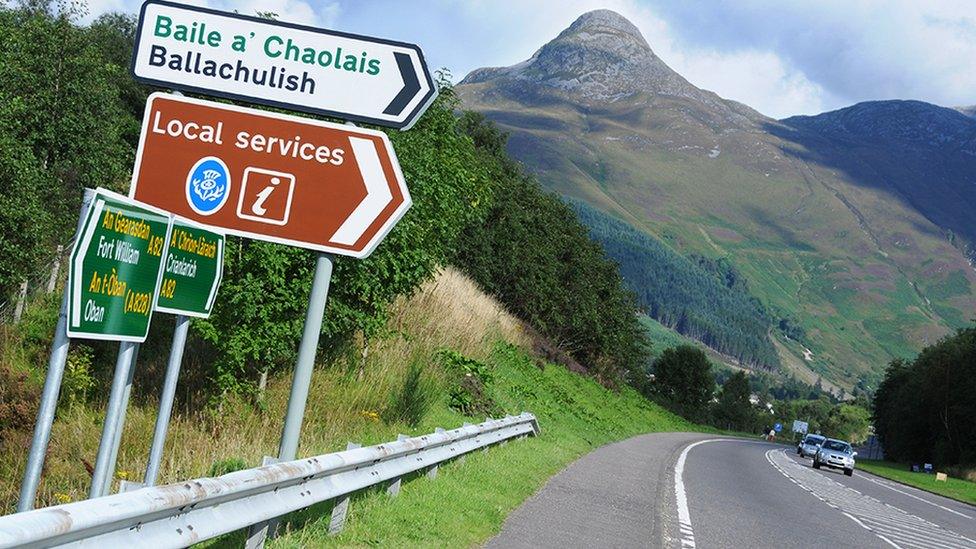General election 2019: The digital ad battle in Scotland
- Published

Advertising on social media has become an everyday part of political campaigning. So, what have Scotland's parties done so far at this election to target voters in key marginals?
How does it work?
Concerns were raised after the 2017 election about party use of paid social media adverts, and the way these "dark ads" were targeting individuals with tailored messages.
In an attempt to improve transparency, Facebook set up an Ad Library, external covering all the adverts posted on its site as well as on Instagram, which it also owns.
This is a tool which lets you search for a political party, group, or even candidate page, and find information about the ads they have bought. This includes rough figures for how much they paid, how many people have seen the ad (or "impressions" to use their lingo), as well as their gender and their approximate age.
The Ad Library is an insight - albeit a limited one - into what messages political parties are seeking to put across, and to whom.
Last month Twitter went one step further and banned political ads altogether, and just this week Snapchat announced it would start fact-checking all campaign ads on its platform.
Which party has taken out the most ads?
With over a third of the seats having been won by a 5% majority or less in the last election, we focused on how voters in 22 Scottish constituencies were being targeted.
So to start at the most basic level, which party is posting the most ads and what are their overarching messages?
The SNP's adverts tend to focus on their Brexit view and attacking the Conservatives, frequently featuring promises to "stop Boris Johnson".
The Scottish Conservatives tend to focus on their opposition to independence, and appealing to unionist Labour voters to back them.
Scottish Labour's nationwide ads have also focused on attacking Mr Johnson and the Tories, although more local candidate ads have tended to pick up on local issues - while notably avoiding the constitutional ones.
And the Lib Dems tend to focus on local messages, as well as their opposition to both Brexit and independence.
Some parties are pushing paid advertising harder than others. Scottish Labour candidates have been taking out more ads (61) than the other three parties put together (43) in the most marginal seats, while the SNP insist they are focusing more on grassroots-sharing than paid content.
Meanwhile, the Scottish Greens don't seem to have posted any ads at all - despite having bought several for their main platform during the European elections earlier in the year.
And if the number of ads are any indicator of key battlegrounds, then keep an eye on:
Fife North East - perhaps conscious of the fact the SNP won this seat by just two votes in 2017, their candidate Stephen Gethins has posted six ads featuring endorsements from business owners and politicians. The Labour and Liberal Democrats have also posted ads here.
Stirling - The Conservatives beat the SNP by just 148 votes last time and both parties have posted five ads each. The former plays on a second independence referendum; the latter on Brexit.
Kirkcaldy and Cowdenbeath - Labour's Lesley Laird - who won by just 259 in 2017 - has posted eight ads to date on issues ranging from health and education, to the gender pay gap.
Going ultra local is a key approach

A big part of this form of political advertising is delivering specific messages to specific groups of people.
At the most simple level, this can be driven by who delivers the message. For all this is a UK election, more local parties are still at the forefront of the campaign.
For example, the Conservatives have run dozens of ads on their national Facebook and Instagram pages, and still more on the official Boris Johnson pages. But none of them has been displayed in Scotland - even ads which are literally about Mr Johnson visiting Scotland haven't been shown north of the border.
Instead the party has focused its Scottish messages through the Scottish Conservative pages - almost like a separate brand - and those of local candidates.
The SNP and the Scottish Lib Dems have not taken out any ads via their main party pages, instead choosing to focus on an even more local level.
Perhaps this is because a top-down approach can occasionally misfire. The Brexit Party has taken out ads aimed specifically at voters in the Labour-held constituencies of Glasgow North East and Coatbridge, Chryston and Bellshill.
The ads claim that "only the Brexit party can defeat Corbyn's Labour" - but they certainly won't be doing it in those seats, given they aren't actually standing candidates.
Putting the candidate front and centre

The whole point of targeted advertising is to put your messages in front of specific voters in specific places, so a lot of them drill down to another level, to constituencies.
Most parties have prioritised ads in the name of individual candidates, running in the local seat they're fighting to win, rather than nation-wide messages.
A prime example is Stephen Kerr, who is defending a majority of just 148 votes in Stirling. The Tories are locked in a real fight with the SNP over this seat, and both sides have been buying ads accordingly.
Mr Kerr's Facebook page has just over 3,000 followers, so is not a huge platform in itself. However, the ads taken out by the page have reached tens of thousands of people. One, which the UK Conservative Party spent more than £1,000 on, has had more than 45,000 "impressions".
The SNP meanwhile has run a series of ads for their candidate, MEP Alyn Smith, on the Stirling SNP page and that of the Trossachs and Teith branch.
This approach can be used to go on the offensive too - in another SNP target seat, Angus, the local party has taken out a series of ads attacking the Tory incumbent, Kirstene Hair, focusing on her record as an MP and only thereafter presenting their candidate as the alternative.
And precision-targeting aside, some candidates have been going slightly more scattergun with a high volume of posts - Labour's Paul Sweeney, defending a majority of 242 votes in Glasgow North East, bought 12 ads in two days at the outset of the campaign.
One final note on candidate-level ads - they don't always come from political parties or the candidates themselves. One group called UK Union Voice has taken out a dozen ads in a series of SNP constituencies and target seats, encouraging "tactical voting" for local challengers from Labour, the Tories and Lib Dems.
Careful targeting of the young and old

Going beyond seat-by-seat targeting, what about adverts that are aimed at specific groups of people?
Facebook's advertising system can be customised to a high degree. As well as filtering for age and gender they can be aimed at people who have liked certain pages or linked themselves to different hobbies or interests.
Ads can even target would-be voters based on location - namely where they connected to the internet and where they used their phone.
An example of effective targeting comes from Andrew Hilland, Labour's candidate in the desperately tight three-way marginal of Lanark and Hamilton East - an SNP defence, but with fewer than 400 votes separating them, the Tories and Labour.
The ad itself is a video about free TV licences for the over-75s, and features the candidate sitting with an older lady. The audience for it was overwhelmingly women over the age of 55, with 26% of all impressions from women over 65 - not the most well-represented demographic on Facebook, but exactly the one Mr Hilland seemed to be aiming for.
A different approach is that taken by Rhea Barnes, Labour's candidate for Argyll and Bute, who has run the exact same advert multiple times, but targeting slightly different demographics each time - including one which was seen exclusively by women over the age of 65.
Behind all of this, we can form a fairly decent picture of who parties are going after in terms of messaging. Scottish Labour's latest nation-wide ads, featuring slickly produced music videos, have been targeted overwhelmingly at 18 to 24-year-olds.
Going completely in the opposite direction, none of the ads by the main Scottish Conservative page have been shown to anyone under the age of 35, and two have been displayed exclusively to those over 45.
Can money buy the reach you want?

All online advertising will be covered by the overall spending rules imposed on parties during a general election campaign, and scrutinised thoroughly by the Electoral Commission in the aftermath.
The nation-wide campaigns have seen the biggest sums spent, with two Scottish Conservative ads having cost more than £5,000 each - and each has been seen by in the region of 200,000 people.
So far, there is little evidence of any individual candidate spending particularly big sums on Facebook and Instagram in Scotland. Mr Sweeney may have taken out a total of 14 ads, but Labour only spent £1,037 on them. The Tories have spent £2,764 on ads for Mr Kerr's page, but this is a drop in the ocean compared to what parties are spending on leaflets and more traditional ads.
We can, however, work out who is getting the most mileage out of the ads being posted, what the advertising world calls the "cost per mille" (CPM) figure - basically what it cost you for 1,000 people to see your ad.
A good example of value for money is Lib Dem candidate Wendy Chamberlain's single ad in North East Fife, which was seen by more than 15,000 mostly young people for an investment in the region of £100. So - very roughly - that's £6.67 for each thousand views.
The man she is seeking to replace, the SNP's Stephen Gethins, spent £151 on his first four ads. But even combined they didn't reach the same number of impressions (8,000) and cost the candidate roughly £19 per thousand views.
The CPM of other political ads varies fairly wildly. A lot of them seem to have had "up to £100" spent on them, and managed "up to 1,000" impressions, making a fairly easy CPM calculation of £100.
The same is true of the ads that have had more money spent on them. One of the Scottish Tory ads in the £5,000 bracket was seen by a maximum of 200,000 people - a CPM of £25.
So spending big money doesn't necessarily guarantee big results.

Notes on our methodology
The list of ads for each marginal seat was compiled by searching Facebook's ad library by ward, and not candidate, name.
This list incorporates ads posted in the 22 marginal constituencies for the period from 24 October to 19 November 2019.
The ad library only provides a range of figures for cost and view data e.g. 3,000 to 4,000 "impressions". In these instances, the lower value was always used.
The calculation of an ad's CPM is based on Facebook's formula, external - namely the total amount spent on an ad, divided by impressions, multiplied by 1,000.
- Published11 November 2019